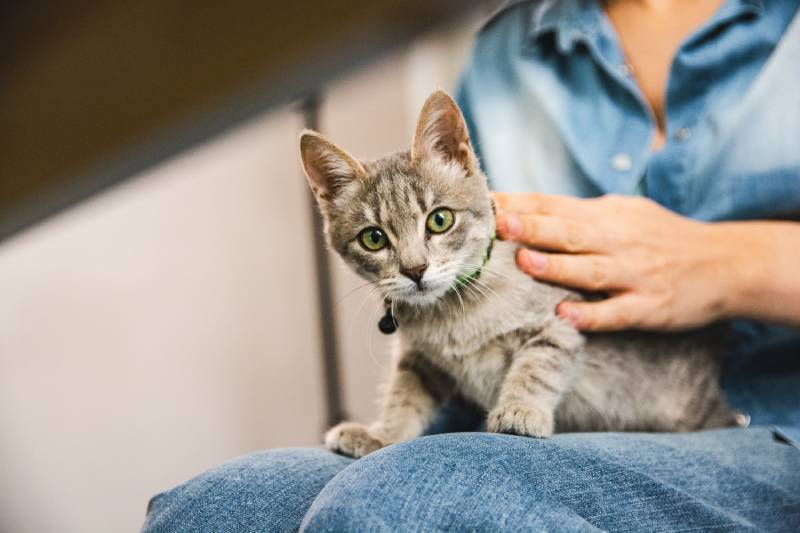How to Foster a Cat: Complete Vet-Approved Guide

Updated on

Click to Skip Ahead
Fostering a cat can be a fun yet challenging experience for both you and the cat. As a foster parent, you’ll provide a safe and loving environment for cats that may have been abandoned, abused, or neglected. You’ll play a crucial role in helping these cats regain their health and trust in humans, and ultimately, find their forever homes. But what is the best way to go about fostering a cat? How much does it cost to foster a cat? How long are you obligated to keep the cat? Let’s discuss.
Why Should You Foster a Cat?
Fostering a cat is an excellent way to help cats in need. There are many reasons why a cat may need fostering. The shelter may be overcrowded, or the cat may be too young to be adopted, recovering from an injury or surgery, or have behavioral issues that require a calm and stable environment. By fostering, you provide a temporary home for the cat until they are ready to be adopted. It also has many benefits for the foster parent. It’s a great way to experience the joys of having a pet without a long-term commitment. Doing it can also be a learning experience, as you learn to care for a cat and provide them with the love and attention they need. On top of that, fostering can also be a way to help you decide if you’re ready for a permanent pet.

Preparing to Foster a Cat
Before you bring home your foster cat, it’s important to actually prepare your home. This includes creating a safe and comfortable environment for your new feline buddy. So here are some tips to help you prepare your place for a foster cat’s arrival.
1. Look At How You Live
The first step in preparing to foster a cat is really to assess your living situation. Consider whether you have enough space for a cat and whether your home is safe for a feline. You should also check with your landlord or homeowner’s association to ensure that pets are allowed in your residence. Note that if you live in an apartment, you may be required to pay a monthly pet fee in addition to your rent. Depending on where you live and your landlord this can be anywhere from $50 to $150 (in the US).
In addition to the above, it’s important to consider the people you live with. If they are fearful of cats or allergic to them, you would want to discuss with them before deciding to foster a cat. In addition, cats may pose risks to pregnant women, which should be considered before deciding to foster them. Immunocompromised people should take extra precautions when sharing a living space with pets (including cats).
2. Buy Some Supplies
Once you’ve determined that you can foster a cat, it is time to gather the necessary supplies. At a minimum, you will need litter boxes, litter, a secure cat transport cage or crate, scratching posts, food and water dishes, toys, and bedding. It’s also advisable to have additional scratching posts, a cat tree, and a few hiding places for the cat (foster cats can be a bit skittish). You can create hiding places by building them out of old cereal boxes or cardboard moving boxes that you have lying around. It’s also important to remember that cats are experts at the art of escaping. You’ll need a cat-proof house for your foster kitty.

3. Register Yourself as a Foster Parent
Many rescue shelters and organizations require you to set up an online profile with relevant information about you, including where you live, your experience with cats, and the types of cats you’re interested in and able to foster. This is an important part of becoming a foster parent. You may also be required to list references and demonstrate some skills (such as the ability to properly restrain and pill a cat) before you can be considered as a foster parent.
4. Check For Any Fostering Requests
Once you’ve registered as a foster parent, periodically check your online page, phone, email, or any other form of communication for when your services are required to foster a cat.
5. Prepare Their “Cat Space”
Before bringing the cat home, prepare a designated space where they can adjust to their new surroundings. This space should be quiet, comfortable, and easily accessible for them. It’s essential to keep the cat confined to this space initially until they become comfortable and familiar with their new environment and anyone else in your home. A secure room that you can monitor from outside (usually via security cameras) is recommended for particularly skittish cats.

6. Slowly Introduce Them to People and Things
When the cat arrives, introduce them to their designated space and provide them with food, water, and toys. In addition, follow through with any special care instructions for the cat. Spend some time with the cat each day to help them acclimate to their new surroundings. It’s important to remember that every cat has its own personality and may require different levels of attention and care. Be cautious when introducing your cat to your family members or other pets in the home. As mentioned earlier, these cats can be very timid and may take time warming up to the new space and people.
7. Address Litterbox and Other Behavior Problems
One common issue that fosters may encounter is litter box problems. Cats can be finicky creatures and may refuse to use the litter box provided to them. This can lead to frustrating situations and even create a mess in the home. As a foster parent, it’s important to understand that this behavior isn’t intentional and will require some patience and lots of understanding – they’re not trying to torture you. This can be solved with consistent training and positive reinforcement. And if need be, you can always reach out to a vet or trainer for help.
Another challenge that fosters may face is behavioral problems. Foster cats may display aggressive or destructive behavior due to fear, anxiety, or other underlying health issues. In some cases, they may even refuse to eat or drink – especially if they’re recovering from illness or surgery. These behaviors require immediate attention and shouldn’t be ignored. So be sure to observe the cat’s behavior closely and report any changes to the vet or animal behaviorist if necessary. But with patience and proper care, most behavioral issues can be resolved over time.

Common Frequent-Asked Questions About Foster Cats
How much does it cost to foster a cat?
The cost of fostering a cat can vary depending on factors such as the length of time the cat will be in your care and any necessary medical expenses. In general, most animal shelters and rescue organizations will cover the cost of food, litter, and basic supplies for the cat. However, you may be responsible for any additional expenses such as veterinary bills or transportation costs. So, make sure you always discuss these details with the organization before committing to fostering a cat to ensure that you’re able and prepared for the financial responsibilities involved.
What is the 3-3-3 rule of adopting a rescue cat?
Essentially, it’s just a guideline (not an actual rule) that helps pet owners ease their newly adopted rescue cats into their homes. The rule suggests that owners should give their cats three days, three weeks, and three months to adjust to their new surroundings. During the first three days, it’s important to give your cat a safe and quiet space to explore. This will help them feel comfortable and relaxed in their new environment. After the first three days, owners should begin to slowly introduce their cat to other areas of the home and other pets.
During the first three weeks, it’s essential to establish a routine for your cat. This includes feeding them at the same time every day, providing them with plenty of toys and scratching posts, and spending time playing with them. Owners should also take their cats to the veterinarian for a check-up during this time. This will ensure that they are healthy and up to date on their vaccinations.
And then, during the first three months, owners should continue to provide their cats with a stable routine and plenty of attention.
Can foster cats be kept with dogs?
It is possible to keep a foster cat with dogs, but it requires proper planning and introduction. First, you’ll need to consider the temperament of your dogs. If they’re aggressive or have a high prey drive, it may not be safe to introduce a foster cat into the household. However, if your dogs are calm and friendly, then yes, they can likely coexist peacefully with a foster cat. The key to introducing a foster cat to dogs is to do it gradually and with patience. So, for example, start by keeping the cat in a separate room for the first few days so that the animals can get used to each other’s scent and presence. Once they’re a bit comfier with each other’s smell, allow them to interact under supervision.

What’s the average age of a foster cat?
The average age of a foster cat can vary greatly. However, most foster cats are typically older kittens or adult cats, ranging from about 6 months to 5 years old. Kittens are usually in high demand for fostering as they need extra care and attention, especially if they were rescued from the streets without their mother. Foster kittens are generally between 2 and 6 months old. On the other hand, adult cats that have been surrendered by their previous owners or rescued from animal shelters also require temporary fostering. These cats can range from 1 to 5 years old and may have varying levels of socialization and medical needs.
Are you obligated to keep the cat if a permanent home can’t be found?
Most of the time, fostering is only a temporary situation until the cat can find a permanent home. Usually, you commit to fostering the cat for a certain amount of time depending on the situation. This can be until the cat reaches a certain age, until they finish recovering from surgery, until there is room in the shelter, or until a home is found. You usually are under no obligation to keep the cat permanently, and if a situation arises that you can’t keep the cat before the amount of time you agreed to is up, the fostering agency can make alternate arrangements for the care of the cat. However, if you do choose to keep the cat, that will be a decision that needs to be made between you and the fostering agency.
Wrapping Things Up
It’s important to note that fostering a cat comes with its own set of challenges, including litter box problems and behavioral issues. As a foster parent, it’s important to remain patient and seek advice from professionals when needed. With proper care and attention, these challenges can be overcome, and the cat can thrive in its new environment. Finally, keep in mind that fostering a cat is just a temporary situation, and the ultimate goal is to find the cat a permanent loving home.
Featured Image Credit: Uplight pictures, Shutterstock













